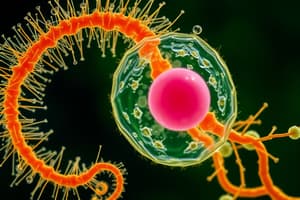Podcast
Questions and Answers
Under normal circumstances, where is a fetus free of microbes?
Under normal circumstances, where is a fetus free of microbes?
- In the birth canal
- In the digestive system
- On the skin
- In utero (correct)
What event exposes a newborn to microbes?
What event exposes a newborn to microbes?
- Breastfeeding
- Birth (correct)
- Vaccination
- First bath
Which term describes a close relationship between two different species in a community?
Which term describes a close relationship between two different species in a community?
- Antagonism
- Competition
- Predation
- Symbiosis (correct)
Which type of symbiotic relationship benefits both organisms involved?
Which type of symbiotic relationship benefits both organisms involved?
In which symbiotic relationship does one organism benefit while the other is neither harmed nor helped?
In which symbiotic relationship does one organism benefit while the other is neither harmed nor helped?
Which symbiotic relationship benefits one organism but harms the other?
Which symbiotic relationship benefits one organism but harms the other?
What type of relationship is it when one organism inhibits the growth of another without being affected itself?
What type of relationship is it when one organism inhibits the growth of another without being affected itself?
What is the term for microorganisms that are normal and expected to be found in certain areas of the body?
What is the term for microorganisms that are normal and expected to be found in certain areas of the body?
Which of the following describes normal flora that are present for a short period?
Which of the following describes normal flora that are present for a short period?
What is the term for normal flora that can cause disease if the balance is disturbed?
What is the term for normal flora that can cause disease if the balance is disturbed?
What are the sites through which pathogens enter the body called?
What are the sites through which pathogens enter the body called?
What is the term for when pathogens come from outside the body?
What is the term for when pathogens come from outside the body?
If a pathogen enters the body through the 'wrong' portal of entry, what is MOST likely to occur?
If a pathogen enters the body through the 'wrong' portal of entry, what is MOST likely to occur?
Which of the following is a portal of entry for pathogens?
Which of the following is a portal of entry for pathogens?
What is a common portal of entry for many pathogens, including those causing respiratory infections?
What is a common portal of entry for many pathogens, including those causing respiratory infections?
Which structure allows some microbes to cross from a pregnant person to their fetus?
Which structure allows some microbes to cross from a pregnant person to their fetus?
Which of the following is NOT mentioned as a potential outcome of pathogens crossing the placenta?
Which of the following is NOT mentioned as a potential outcome of pathogens crossing the placenta?
Which of the following is an example of resident flora?
Which of the following is an example of resident flora?
Which of the following is an example of transient flora listed?
Which of the following is an example of transient flora listed?
What is the term for microbes that can cross the placenta causing spontaneous abortions, birth defects, or premature births?
What is the term for microbes that can cross the placenta causing spontaneous abortions, birth defects, or premature births?
What category of symbiotic relationship does E. coli represent in the human GI tract?
What category of symbiotic relationship does E. coli represent in the human GI tract?
What category of symbiotic relationship does mycobacteria inhabiting the ear represent?
What category of symbiotic relationship does mycobacteria inhabiting the ear represent?
What category of symbiotic relationship do helminths represent?
What category of symbiotic relationship do helminths represent?
What category of symbiotic relationship does penicillium represent?
What category of symbiotic relationship does penicillium represent?
What is another term for normal flora?
What is another term for normal flora?
Which of the following can normal flora NOT cause if they are protective?
Which of the following can normal flora NOT cause if they are protective?
What causes normal flora to become opportunistic pathogens?
What causes normal flora to become opportunistic pathogens?
What term is used to describe the majority of pathogens having their preferred site of entry?
What term is used to describe the majority of pathogens having their preferred site of entry?
What happens if a pathogen enters the 'wrong' portal?
What happens if a pathogen enters the 'wrong' portal?
Which virus is able to cross the placenta?
Which virus is able to cross the placenta?
Which bacteria is able to cross the placenta?
Which bacteria is able to cross the placenta?
Which parasite is able to cross the placenta?
Which parasite is able to cross the placenta?
Which spirochete listed can cross the placenta?
Which spirochete listed can cross the placenta?
What category does Rubivirus fall under?
What category does Rubivirus fall under?
What category does parvovirus B-19 fall under?
What category does parvovirus B-19 fall under?
What type of bacteria is _E. Coli?
What type of bacteria is _E. Coli?
During what process is a newborn exposed to microbes?
During what process is a newborn exposed to microbes?
What can crossing of microbes over the placenta cause?
What can crossing of microbes over the placenta cause?
Flashcards
Symbiosis
Symbiosis
A close relationship between two different species of organisms in a community.
Mutualism
Mutualism
Both members benefit from the interaction. E.g., E. coli in the human GI tract.
Commensalism
Commensalism
One organism benefits and the other is neither harmed nor helped; e.g. some mycobacteria inhabit the ear.
Parasitism
Parasitism
Signup and view all the flashcards
Amensalism
Amensalism
Signup and view all the flashcards
Resident flora
Resident flora
Signup and view all the flashcards
Transient flora
Transient flora
Signup and view all the flashcards
Normal flora
Normal flora
Signup and view all the flashcards
Opportunistic pathogens
Opportunistic pathogens
Signup and view all the flashcards
Portal of Entry
Portal of Entry
Signup and view all the flashcards
Exogenous
Exogenous
Signup and view all the flashcards
Endogenous
Endogenous
Signup and view all the flashcards
Placental transfer
Placental transfer
Signup and view all the flashcards
Study Notes
- Under normal conditions, a fetus in utero is microbe-free.
- During birth, a newborn gets exposed to microbes, which starts colonizing the infant’s intestine.
Symbiosis
- A close relationship between two different species of organisms in a community.
- Mutualism: Both members benefit from the interaction such as E. coli in the human GI tract.
- Commensalism: One organism benefits and the other is neither harmed nor helped such as some mycobacteria inhabiting the ear (living on secretions and dead cells) which are normal flora.
- Parasitism: One organism benefits, while the other is harmed such as T.B., helminths and protozoa.
- Amensalism: One organism can hamper or prevent the growth/survival of another, without being affected by the other organism such as penicillium.
Normal Flora (Microbiota)
- Resident flora: normal flora throughout the life of a person such as S. epidermidis and E. Coli.
- Transient flora: remain for a few hours, days, or months before they vanish such as Bacillus Laterosporus (sometimes lives in intestine to limit growth of Candida).
- Normal flora are usually protective, so they do not cause diseases in their normal habitat in a healthy person.
- When balance is interrupted, normal flora can become opportunistic pathogens.
Portal of Entry
- Exogenous
- Endogenous
- The majority of pathogens have their preferred portal of entry.
- If a pathogen enters the “wrong” portal, infection will not occur.
- Some infectious agents enter via more than one portal such as Streptococcus and Staphylococcus.
Portals of Entry
- Skin
- Mucous membranes
- Placenta: some microbes cross the placenta causing spontaneous abortions, birth defects, or premature births.
- Examples of microbes that can cross the placenta: HIV, Rubivirus, Cytomegalovirus, Parvovirus B-19, Treponema pallidum, Listeria monocytogenes, and Toxoplasma gondii.
Studying That Suits You
Use AI to generate personalized quizzes and flashcards to suit your learning preferences.




